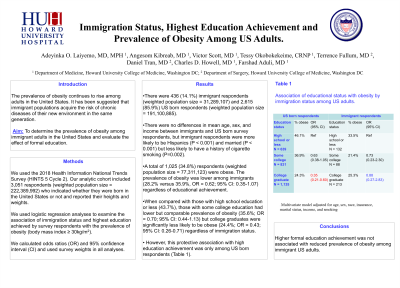Monday Poster Session
Category: Obesity
P2619 - Immigration Status, Highest Education Achievement, and Prevalence of Obesity Among US Adults
Monday, October 23, 2023
10:30 AM - 4:15 PM PT
Location: Exhibit Hall

Has Audio

Adeyinka Laiyemo, MD, MPH, FACG
Howard University Hospital
Washington, District of Columbia
Presenting Author(s)
Laiyemo Adeyinka, MD, MPH, FACG1, Angesom Kibreab, MD2, Victor Scott, MD3, Tessy Okobokekeime, ARNP3, Terrence Fullum, MD3, Daniel Tran, MD3, Charles Howell, MD3, Farshad Aduli, MD1
1Howard University Hospital, Washington, DC; 2Howard University Hospital, Washington, WA; 3Howard University, Washington, DC
Introduction: The prevalence of obesity continues to rise among adults in the United States. It has been suggested that immigrant populations acquire the risk of chronic diseases of their new environment in the same generation.
Aim: To determine the prevalence of obesity among immigrant adults in the United States and evaluate the effect of formal education.
Methods: We used the 2018 Health Information National Trends Survey (HINTS 5 Cycle 2). Our analytic cohort included 3,051 respondents (weighted population size = 222,389,992) who indicated whether they were born in the United States or not and reported their heights and weights. We used logistic regression analyses to examine the association of immigration status and highest education achieved by survey respondents with the prevalence of obesity (body mass index ≥ 30kg/m2). We calculated odds ratios (OR) and 95% confidence interval (CI) and used survey weights in all analyses.
Results: There were 436 (14.1%) immigrant respondents (weighted population size = 31,289,107) and 2,615 (85.9%) US born respondents (weighted population size = 191,100,885).
There were no differences in mean age, sex, and income between immigrants and US born survey respondents, but immigrant respondents were more likely to be Hispanics (P < 0.001) and married (P < 0.001) but less likely to have a history of cigarette smoking (P=0.002).
A total of 1,025 (34.8%) respondents (weighted population size = 77,311,123) were obese. The prevalence of obesity was lower among immigrants (28.2% versus 35.9%, OR = 0.62; 95% CI: 0.35-1.07) regardless of educational achievement. When compared with those with high school education or less (43.7%), those with some college education had lower but comparable prevalence of obesity (35.6%; OR = 0.70; 95% CI: 0.44-1.13) but college graduates were significantly less likely to be obese (24.4%; OR = 0.43; 95% CI: 0.26-0.71) regardless of immigration status. However, this protective association with high education achievement was only among US born respondents (Table 1).
Discussion: Higher formal education achievement was not associated with reduced prevalence of obesity among immigrant US adults.
Disclosures:
Laiyemo Adeyinka, MD, MPH, FACG1, Angesom Kibreab, MD2, Victor Scott, MD3, Tessy Okobokekeime, ARNP3, Terrence Fullum, MD3, Daniel Tran, MD3, Charles Howell, MD3, Farshad Aduli, MD1. P2619 - Immigration Status, Highest Education Achievement, and Prevalence of Obesity Among US Adults, ACG 2023 Annual Scientific Meeting Abstracts. Vancouver, BC, Canada: American College of Gastroenterology.
1Howard University Hospital, Washington, DC; 2Howard University Hospital, Washington, WA; 3Howard University, Washington, DC
Introduction: The prevalence of obesity continues to rise among adults in the United States. It has been suggested that immigrant populations acquire the risk of chronic diseases of their new environment in the same generation.
Aim: To determine the prevalence of obesity among immigrant adults in the United States and evaluate the effect of formal education.
Methods: We used the 2018 Health Information National Trends Survey (HINTS 5 Cycle 2). Our analytic cohort included 3,051 respondents (weighted population size = 222,389,992) who indicated whether they were born in the United States or not and reported their heights and weights. We used logistic regression analyses to examine the association of immigration status and highest education achieved by survey respondents with the prevalence of obesity (body mass index ≥ 30kg/m2). We calculated odds ratios (OR) and 95% confidence interval (CI) and used survey weights in all analyses.
Results: There were 436 (14.1%) immigrant respondents (weighted population size = 31,289,107) and 2,615 (85.9%) US born respondents (weighted population size = 191,100,885).
There were no differences in mean age, sex, and income between immigrants and US born survey respondents, but immigrant respondents were more likely to be Hispanics (P < 0.001) and married (P < 0.001) but less likely to have a history of cigarette smoking (P=0.002).
A total of 1,025 (34.8%) respondents (weighted population size = 77,311,123) were obese. The prevalence of obesity was lower among immigrants (28.2% versus 35.9%, OR = 0.62; 95% CI: 0.35-1.07) regardless of educational achievement. When compared with those with high school education or less (43.7%), those with some college education had lower but comparable prevalence of obesity (35.6%; OR = 0.70; 95% CI: 0.44-1.13) but college graduates were significantly less likely to be obese (24.4%; OR = 0.43; 95% CI: 0.26-0.71) regardless of immigration status. However, this protective association with high education achievement was only among US born respondents (Table 1).
Discussion: Higher formal education achievement was not associated with reduced prevalence of obesity among immigrant US adults.
Disclosures:
Laiyemo Adeyinka indicated no relevant financial relationships.
Angesom Kibreab indicated no relevant financial relationships.
Victor Scott indicated no relevant financial relationships.
Tessy Okobokekeime indicated no relevant financial relationships.
Terrence Fullum indicated no relevant financial relationships.
Daniel Tran indicated no relevant financial relationships.
Charles Howell indicated no relevant financial relationships.
Farshad Aduli indicated no relevant financial relationships.
Laiyemo Adeyinka, MD, MPH, FACG1, Angesom Kibreab, MD2, Victor Scott, MD3, Tessy Okobokekeime, ARNP3, Terrence Fullum, MD3, Daniel Tran, MD3, Charles Howell, MD3, Farshad Aduli, MD1. P2619 - Immigration Status, Highest Education Achievement, and Prevalence of Obesity Among US Adults, ACG 2023 Annual Scientific Meeting Abstracts. Vancouver, BC, Canada: American College of Gastroenterology.
